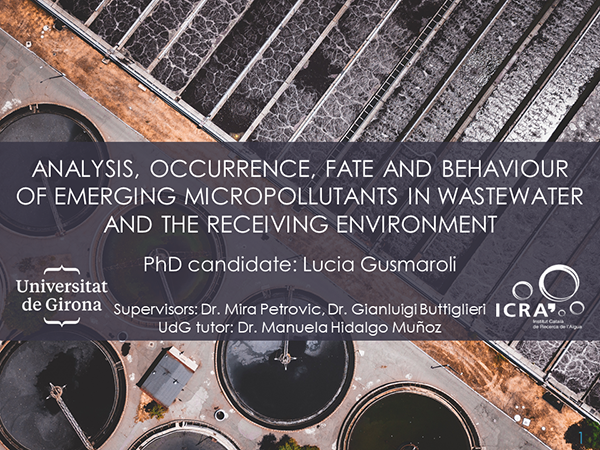Services

Last Monday, May 25, Lucia Gusmaroli defended the doctoral thesis “Analysis, occurrence fate and behavior of emerging micropollutants in wastewater and the receiving environment”, directed by Drs. Mira Petrovic (ICRA-ICREA) and Gianluigi Buttiglieri (ICRA).
The presence of micropollutants in the aquatic environment has given rise to great environmental concern and, to solve this problem, the European Union is updating its legislation. A total of 17 emerging pollutants, candidates to be added to the list of priority substances, have been included in a watch list (Watch list) and must be monitored by all member states to collect data on their presence in fresh water .
The main objective of Lucia Gusmaroli’s thesis was to fill the gaps in knowledge about the Watch list compounds (EU Decision 2015/495) at three levels: analysis, monitoring and elimination.
First, an analytical methodology based on online SPE-UHPLC-MS/MS was developed for the simultaneous determination of Watch list compounds in both freshwater and wastewater (effluents and influents).
The method was applied to the monitoring of Watch list compounds in the Ebro Delta, an area of great environmental and economic importance. The results show that the extent of contamination in fresh water is not negligible, with total concentrations of up to 2.39 mg/L. Pesticides were detected in all freshwater samples and drugs are the class that contributes most of the contamination, with azithromycin and diclofenac being the compounds at the highest concentrations. The concentration levels of the investigated compounds are above the predicted no effect concentration (PNEC) values in most of the samples.
At the same time, 8 of the compounds on the Watch list were studied in (bio)degradation experiments, with the dual objective of exploring their removal in conventional activated sludge systems and evaluating the importance of the operational parameters of WWTPs with the ‘objective to improve elimination rates. The maximum removal is verified in aerobic conditions, high temperature (25 ° C), higher biomass concentration (5 g/L) and high pH (7.5) and the parameters with the greatest impact on the removal rates are concentration of biomass and redox conditions.
In general, the results presented in this thesis show that the Watch List compounds are currently only partially removed during conventional treatment, with room for improvement. It should be noted that the compounds on the Watch list can represent a threat to the environment in the concentration at which they occur, as confirmed by the monitoring results.